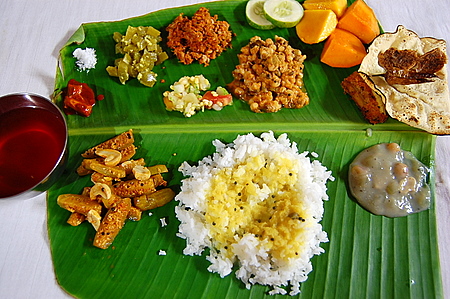For those of us that adore the rich, varied and exotic tradition of Indian food, paying a visit to one of London’s best Indian fine dining restaurants might present us with something of a challenge. The mouth-watering menus contain a list of exquisite and inventive dishes – how is it possible to choose just one meal?
Of course, the more savvy diners among us might decide to order the Indian way and share food, choosing a selection of dishes to dip in and out of and a few tasty flat breads or pots of rice to pass around. Problem solved!

Another solution is practiced in the South Indian state of Kerala, where a traditional feast follows a pattern steeped in history and culture, serving up course upon course – enough to satiate even the hungriest members of the party. The word for banquet is sadhya and this spread tends to signify a celebratory occasion, marking it with some serious eating.
Setting up for a Sadhya
A traditional Sadhya would be expected to take place on a special occasion such as a wedding, a birthday or to celebrate a festival or holiday. As it is a South Indian tradition, a region where many people adhere to religious beliefs prohibiting them from eating animal flesh, the feast consists of vegetarian specialities – in this inclusive manner, anyone can partake in a Sadhya.
A Sadhya would usually take place at lunchtime and although nowadays many people prefer to eat at tables, traditionally diners would seat themselves cross-legged on the floor. A large, flat banana leaf serves as a plate and each dish is presented in a certain order, placed on specific parts of the leaf.
Once you are fully satisfied and after all your courses have come and gone, you can demonstrate you are finished by folding your leaf. Just be sure to close it away from you to show enjoyment, as towards you indicates a need for improvement!
Traditional Foods of a Sadhya
A Sadhya consists of many small dishes that come together to form a course and the dishes vary according to the religion of the people attending, the occasion that is being celebrated and the area of Kerala. It has been known, for example, in the north of the state, to include the occasional non-vegetarian dish.
However, there are commonalities. The main bulk of the meal is always rice served with a selection of dishes known as kootan. This collection includes curries and spicy, lentil preparations such as sambar, rasam and parippu. An assortment of flavoursome pickles and chutneys would also form an integral part of the kootan. At the end of a Sadhya, the traditional dessert served is known as payasam and usually consists of several dishes as well.
The incorporation of different dishes at different courses contributes to the inclusive atmosphere – it is likely there will be a dish to suit everyone’s personal preferences at a Sadyha.
Often the meal will end with an unusual routine of chewing betel lead with spices and lime. This is believed to help begin the digestive processes as well as cleansing the palate.If you want to have the mouth watering experience of traditional south indian feast then you can visit: http://www.amaya.biz/























